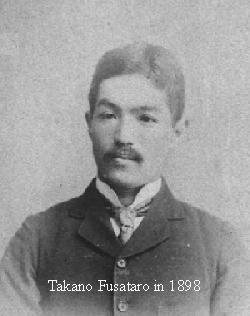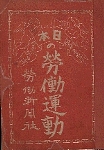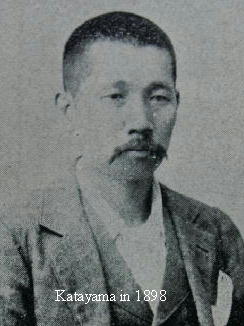
Preface
Takano Fusatarô was the founding father of Japan's modern labor union movement and a pioneer of the cooperative movement. His name often appears in entrance examinations for universities in Japan, so he can certainly be said to be a widely recognized historical figure. Yet despite this, no biography of him worth reading has yet been published, whereas, quite a few biographies and monographs have appeared about Katayama Sen, one of the Takano's fellow pioneers in the early labor movement. In fact, there is a book on Takano Fusataro in English, but its rough sketches of Takano's life contained many errors and misunderstandings.
It was the idea of filling that void stimulated me to publish the book and this translation.
But besides seeking to describe the life of Takano Fusatarô, the book has another purpose, which is to shed light on the formative years of the Japanese labor union movement.
 Those works which have sought to depict the beginnings of the labor movement in Japan share a common difficulty in that, in their accounts of this period, they depend heavily and uncritically on Nihon no rôdô undô (The Labor Movement in Japan) by Katayama Sen and Nishikawa Mitsujirô, and as a result, their grasp of the facts is often less than accurate. A book written by the leader of the movement at the time in question is a valuable historical resource, and reference should certainly be made to it. Nevertheless, while Katayama was indeed a key figure in the early labor movement, he came to it when it was already underway. In the book, the period prior to Katayama's participation tends to be oversimplified, and the facts pertaining to it are thus rendered problematic. Consequently, it is still the case that incorrect information about the burgeoning period of the Japanese labor movement crops up here and there, and the evaluation of the actual achievements of the participants is inappropriate. Even in the simple accounts of conventional histories, such as in the Japanese Wikipedia entry for 'Nihon no rôdô undôshi' (History of the Labor Movement in Japan), one comes across cases in which historical facts are not presented correctly. To rectify this situation was a further aim of this book.
Those works which have sought to depict the beginnings of the labor movement in Japan share a common difficulty in that, in their accounts of this period, they depend heavily and uncritically on Nihon no rôdô undô (The Labor Movement in Japan) by Katayama Sen and Nishikawa Mitsujirô, and as a result, their grasp of the facts is often less than accurate. A book written by the leader of the movement at the time in question is a valuable historical resource, and reference should certainly be made to it. Nevertheless, while Katayama was indeed a key figure in the early labor movement, he came to it when it was already underway. In the book, the period prior to Katayama's participation tends to be oversimplified, and the facts pertaining to it are thus rendered problematic. Consequently, it is still the case that incorrect information about the burgeoning period of the Japanese labor movement crops up here and there, and the evaluation of the actual achievements of the participants is inappropriate. Even in the simple accounts of conventional histories, such as in the Japanese Wikipedia entry for 'Nihon no rôdô undôshi' (History of the Labor Movement in Japan), one comes across cases in which historical facts are not presented correctly. To rectify this situation was a further aim of this book.
Takano Fusatarô was born in January 1869, just after the name of the imperial reign year was changed from Keiô to Meiji. He was a contemporary of some familiar names, such as, in Japan: Natsume Sôseki (novelist, b.1867), Yokoyama Taikan (painter, 1868), Tokutomi Roka (author, 1868), and Sakai Toshihiko (socialist, 1870), and abroad: Maxim Gorky (1868), Mahatma Gandhi, Emma Goldman, André Gide, Henri Matisse (all four above, 1869), and Vladimir Lenin (1870) . However, the organization Takano created faded after a short period of time and its achievements were underestimated by his contemporaries, so even his name was almost forgotten for many years. As Takano died at the relatively early age of 35, there are not so many historical documents dealing with his life. There are no surviving pieces of his own writing about himself, and the fact that only a few written memoirs exist by those who knew him makes writing a biography difficult.
One way of surmounting this hurdle would be to write "Takano Fusatarô - A Novel". Such an imaginative story which would bring to life the times in which the man lived, the places where he lived, the atmosphere he breathed, and the details of his daily existence; it would be easy to read and would provide readers with a clear-cut image of his personality and character. However, I have many doubts about the merit of a fictional-style approach to biography. While such accounts may able to give a lively and attractive portrayal of the protagonist's personality, I cannot help questioning the factual basis for such a portrayal and have often doubted the merit of departing substantially from the known historical facts. These accounts are works of literature, so of course they do not need to be bound by factual accuracy, and a work's departure from the historical facts is certainly no reason to decry its literary merit. However, the researcher's natural tendency, which ought to be called a professional disease - "doubt in all things" - acts as a preventative against a simple acceptance of 'biographical literature'. I strongly feel that in order to portray the life of someone who actually existed, I would want to begin by gathering as many historical resources as possible and after these had been subjected to a critical examination, on this basis of having established the known facts, I could proceed to present a picture of the historical personality. Even where direct historical resources are lacking, many related accounts can be used to approach the actual historical circumstances.
To reproduce that individual's life, one must of course depict the society and times in which he lived. A historian's method and style of writing are naturally different from those of a novelist. It may seem as if I am bragging but I have confidence in the considerable experience I have accumulated over the years in the discovery and critical evaluation of historical source materials.
There are of course limits to a method that places a premium on actual evidence. It is impossible to portray the life of a historical individual by completely eschewing speculation and imagination. To reconstruct a life by basing it only on historical documents that happen to be extant would resemble a shriveled mummy and would itself only represent a distorted image of that life. In certain circumstances one needs to make full use of the imagination and allow oneself some bold conjectures. But in such cases, I shall make clear why I have judged them to be necessary and on what basis I do so.
Takano Fusatarô was born in Nagasaki, spent his youth in Tokyo and Yokohama, and at the end of 1886, just before he turned 18 years old, he traveled to America. He went in the hope of making a success of himself in business but failed in his management of a Japanese general store in San Francisco and was much discouraged. After that, he had a succession of jobs in various places in the West Coast region, in the lumbering industry, and in restaurants as a waiter while studying English and economics.
During this time he became interested in the labor movement, and in the summer of 1891, he founded the Shokkô giyûkai (The Friends of Labor) with some Japanese friends in San Francisco. This organization was the actual fount of the Japanese labor movement. In 1894 he met with Samuel Gompers, the President of the American Federation of Labor (AFL) and exchanged views on the future form of labor unions in Japan. Impressed by Takano's energy and ability, Gompers appointed him AFL organizer for Japan.
In 1894, in order to repay the money he had borrowed following the failure of his business, Takano replied to a recruitment drive for the US Navy and as a sailor on a gunboat in the US Asian Fleet, he traveled round the world, returning to Japan in 1896.
In the spring of 1897, back in Tokyo, Takano Fusatarô reorganized the Friends of Labor with his friends from his years in San Francisco, Jô Tsuntarô and Sawada Han'nosuke, and in April that year wrote and published the first pamphlet of the Japanese labor movement, "A Call to All Workers" (Shokkô shokun ni yosu), which called for the formation of labor unions.
In June a public lecture meeting on labor issues was held under the auspices of the Friends of Labor. Christian social reformer Katayama Sen's involvement with the labor movement dates from his speech on this occasion.  The meeting was a great success and was followed in July by the formation of the 'Association for Encouragement and Formation of Trades Unions' (Rôdôkumiai kiseikai). The end of the year then saw the founding of the Ironworkers' Union (Tekkô kumiai). For these two organizations, the Society for the Formation of Labor Unions, which served as the promotional group for the cause of the labor union movement, and for the Ironworkers' Union, Japan's first modern labor union, Takano worked tirelessly all year round as their unpaid representative. He also opened and managed a cooperative store in Yokohama. The meeting was a great success and was followed in July by the formation of the 'Association for Encouragement and Formation of Trades Unions' (Rôdôkumiai kiseikai). The end of the year then saw the founding of the Ironworkers' Union (Tekkô kumiai). For these two organizations, the Society for the Formation of Labor Unions, which served as the promotional group for the cause of the labor union movement, and for the Ironworkers' Union, Japan's first modern labor union, Takano worked tirelessly all year round as their unpaid representative. He also opened and managed a cooperative store in Yokohama.
He was active as the leader of the labor movement from the beginning of 1897 until the summer of 1900 - three and a half years. During this period, more than 5,000 workers joined labor unions. For Japan, a country with no tradition of labor unions, the social experiment to create a labor union movement from zero had by this point achieved some success. However, government pressure and opposition from employers strengthened, and the movement soon experienced a sharp decline. Disappointed, Takano left for China and tried again to set up in business there, but once more without success. He fell ill, and died in the city of Qingdao, Shandong Province, in March 1904. It had been a life of just 35 years and 2 months.
Why did a man who wanted a career in business come to be interested in the labor movement? Why did he become the organizer of labor unions and cooperatives? What kind of roles did he play in the movement? Why was the movement able to grow so fast, but then soon declined? Why were the workers who responded to his call mainly those who worked in large factories of heavy industry such as the Tokyo Arsenal and Ishikawajima Shipyard? What was the secret of his mastery of the English language? Takano's life presents us with a number of riddles.
In what follows I shall try to solve these riddles as I uncover the life of this man. The book may serve as a 'dramatic' portrayal of the life of Takano Fusatarô, but my main focus is on solving certain riddles. I shall bring forward a number of questions which I shall seek to answer with a method that may sometimes seem a little roundabout. It will be an 'historical detective's investigative report'. Unlike detective stories, this account will lack any clear-cut explanations and will feel its way toward answers in a manner that may seem neither fish nor fowl. The reader may therefore at times feel irritated that a conclusion is being avoided or that the story is becoming overly academic; but to find traces of the criminal at a crime scene where there is little evidence calls for a special way of working. If the persistent reader will accompany me through the process of solving the riddles set by Takano Fusatarô, I shall be content.

This is the English translation of the book Rôdô wa shinsei nari ketsugô wa seiryoku nari; Takano Fusatarô to sono jidai',(Iwanami Shoten Publishers, 2008.), Hajimeni
|


 Those works which have sought to depict the beginnings of the labor movement in Japan share a common difficulty in that, in their accounts of this period, they depend heavily and uncritically on Nihon no rôdô undô (The Labor Movement in Japan) by Katayama Sen and Nishikawa Mitsujirô, and as a result, their grasp of the facts is often less than accurate. A book written by the leader of the movement at the time in question is a valuable historical resource, and reference should certainly be made to it. Nevertheless, while Katayama was indeed a key figure in the early labor movement, he came to it when it was already underway. In the book, the period prior to Katayama's participation tends to be oversimplified, and the facts pertaining to it are thus rendered problematic. Consequently, it is still the case that incorrect information about the burgeoning period of the Japanese labor movement crops up here and there, and the evaluation of the actual achievements of the participants is inappropriate. Even in the simple accounts of conventional histories, such as in the Japanese Wikipedia entry for 'Nihon no rôdô undôshi' (History of the Labor Movement in Japan), one comes across cases in which historical facts are not presented correctly. To rectify this situation was a further aim of this book.
Those works which have sought to depict the beginnings of the labor movement in Japan share a common difficulty in that, in their accounts of this period, they depend heavily and uncritically on Nihon no rôdô undô (The Labor Movement in Japan) by Katayama Sen and Nishikawa Mitsujirô, and as a result, their grasp of the facts is often less than accurate. A book written by the leader of the movement at the time in question is a valuable historical resource, and reference should certainly be made to it. Nevertheless, while Katayama was indeed a key figure in the early labor movement, he came to it when it was already underway. In the book, the period prior to Katayama's participation tends to be oversimplified, and the facts pertaining to it are thus rendered problematic. Consequently, it is still the case that incorrect information about the burgeoning period of the Japanese labor movement crops up here and there, and the evaluation of the actual achievements of the participants is inappropriate. Even in the simple accounts of conventional histories, such as in the Japanese Wikipedia entry for 'Nihon no rôdô undôshi' (History of the Labor Movement in Japan), one comes across cases in which historical facts are not presented correctly. To rectify this situation was a further aim of this book.
 The meeting was a great success and was followed in July by the formation of the 'Association for Encouragement and Formation of Trades Unions' (Rôdôkumiai kiseikai). The end of the year then saw the founding of the Ironworkers' Union (Tekkô kumiai). For these two organizations, the Society for the Formation of Labor Unions, which served as the promotional group for the cause of the labor union movement, and for the Ironworkers' Union, Japan's first modern labor union, Takano worked tirelessly all year round as their unpaid representative. He also opened and managed a cooperative store in Yokohama.
The meeting was a great success and was followed in July by the formation of the 'Association for Encouragement and Formation of Trades Unions' (Rôdôkumiai kiseikai). The end of the year then saw the founding of the Ironworkers' Union (Tekkô kumiai). For these two organizations, the Society for the Formation of Labor Unions, which served as the promotional group for the cause of the labor union movement, and for the Ironworkers' Union, Japan's first modern labor union, Takano worked tirelessly all year round as their unpaid representative. He also opened and managed a cooperative store in Yokohama.